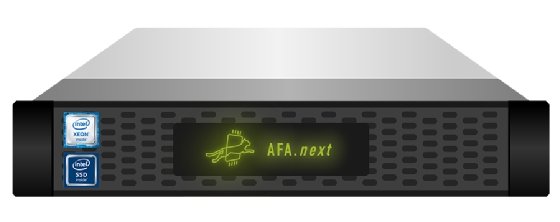
kentoh - Fotolia
Startup StorOne incorporates Intel Optane
StorOne claims it will show the storage giants how to get the most out of Intel Optane drives, incorporating them alongside cheaper QLC SSDs in an all-flash array.
StorOne is taking a two-tier, no cache approach to try to make Intel Optane solid-state drives perform better than the large array vendors.
StorOne's All-Flash Array.next (AFAn), which launched this week, combines high-performance Optane drives with lower-cost capacity quad-level cell (QLC) SSDs. The Intel servers use StorOne's S1 storage management software to write data to the most efficient tier.
StorOne and its distribution partners will sell the S1: AFAn systems, which include 3 TB or 4.5 TB of Optane capacity and 20 TB, 43 TB, 89 TB, 179.5 TB, 363.5 TB or 731.5 TB of QLC 3D NAND in each chassis. StorOne chief marketing officer George Crump said nodes can be clustered to up to 15 PB of capacity.
Pricing starts at $59,184 for a single node with 3 TB of Optane SSDs and 20 TBs of QLC, and ranges to $396,326 for 4.5 TB of Optane and 731.5 TB of QLC capacity. High-availability configurations -- including mirroring to a second box without Optane -- range from $88,76 for 23 TB to $594,489 for 736 TB. Customers can price the systems on StorOne's TruPrice portal.
Crump said the AFAn is designed for traditional VMware and database workloads, but it performs well enough to also run analytics using artificial intelligence and machine learning. "We don't think it makes sense to have a storage system that does one thing," he said.
Intel Optane, based on the vendor's 3D XPoint technology storage class memory, is faster than NAND flash but denser than memory. Although it is available in storage systems from the major vendors, it has yet to widely catch on because of its high price tag.
QLC drives are the slowest, least durable and least expensive SSDs available. StorOne uses the bulk storage QLC SSDs to keep the price down while counting on Optane for performance.
StorOne's DirectWrite feature writes directly to the storage media, lowering latency during writes to Optane. After writing to Optane, the S1: AFAn tiers less frequently accessed data to QLC.
QLC, which holds greater capacity than Optane, writes data slower than hard disk drives but reads almost as fast as Optane. DirectWrite sends the writes to the faster Optane but reads data off QLC.

Crump said StorOne modified its software a bit to accommodate Optane, but it is the same underlying code. IDC research vice president Eric Burgener said S1 brings out the value in Optane in the AFAn.
"It's the Optane media that really supercharges this idea," Burgener said. "They can get maximum utilization. It doesn't have features such as stretched cluster and other availability capabilities of storage arrays, but StorOne's claim is economic value -- they can give the same IOPS and capacity for $400,000 as a million-dollar [Dell EMC] PowerMax."
StorOne isn't the only vendor supporting Intel Optane drives. The major storage array vendors do also, although at a higher price tag. Dell EMC PowerMax, Pure FlashArray, NetApp Memory Accelerated Data and Hewlett Packard Enterprise Nimble Storage arrays support Optane SSDs. Startup Vast Data also uses Optane and QLC drives as tiers inside one platform, although that is aimed more at unstructured and secondary data, while AFAn is a block storage system.
"Vast has taken a more holistic look at the entire infrastructure, with servers, storage and networking," Burgener said. "StorOne is trying to build a better mousetrap for arrays with Optane and QLC. The write performance of Optane is significantly better than QLC, and writing to Optane can solve QLC durability issues."
Scott Sinclair, a senior analyst at Enterprise Strategy Group, said "I'm interested to see how storage vendors can maximize the value of Optane."
Sinclair said early flash storage systems were commonly hybrids that used flash for performance and hard disk drives for capacity. With Optane and QLC in the same box, everything is read from flash. "It's flash and flash, not flash and disk," Sinclair said.








